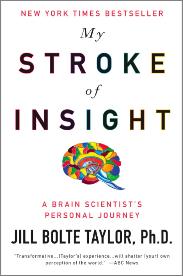
Book Review of My Stroke of Insight by Jill Bolte Taylor, PhD
published in The Art of Teaching
reviewed by Gail Bursch, Belmont University School of Physical Therapy
In the midst of beginning another hectic school year, take a deep breath and a moment to imagine the consequences of suddenly having a stroke or traumatic brain injury. Consider the misfortune of a successful neuroscientist, who taught Harvard medical students and conducted research at the Brain Bank, having a massive stroke at the age of 37. After surviving a massive bleed in the left hemisphere of her brain, Dr. Jill Taylor wondered if she would be able to speak again, to walk again and would they take her PhD away?
The ways in which Jill connected with the outside world for help during the four hours her brain was hemorrhaging is an amazing story. Because the left hemisphere contains the speech and language centers, she could not speak intelligibly nor recognize phone numbers. Each normal function shut down one by one as the bleed progressed. The curious neuroscientist in her monitored the details; overcoming the fear and desire to succumb to a peaceful death. Jill described the loss of her ‘brain chatter’, which refers to the left brain monitoring time and details, categorizing everything so that we can make sense of the world. With the left brain injured, her right brain became dominant resulting in silent euphoria and feeling at one with the universe.
During the hospital stay through brain surgery to remove the golf ball-sized clot, Jill describes the warm and comforting silence in her right brain pulling her towards sleep and shutting out the busy chaos of the hospital. She could not distinguish one object from the other due to the right brain seeing only the big picture and not boundaries. Therefore, she could not see people until they moved against the background. Color discrimination was also absent. Her visual world was a mosaic of vibrating energy sources. All noises were painful and magnified. For months, she could not tolerate television or radio and perceived that input as a screaming intrusion. Although she could not understand people talking to her, the right brain sensed compassion versus healthcare workers who were just in a hurry to complete their tasks.
Her memories and life experiences were like files locked in file cabinets and it was slow, hard work to learn to access the files. Going to her 20th high school reunion six months after her surgery helped to activate a lot of memories by cues from her friends. Jill concentrated on mental imagery to keep the neural circuits alive in her brain long before she was able to perform a task with her body. As she regained her left brain function, Jill purposefully chose not to reactivate the negative loops of thought; her emotional baggage. She recounts the effort of physical recovery as minimal compared to rebuilding her mind.
Some of the inconceivable challenges during her recovery included:
– Three months of her mother’s live-in care and training similar to when she was an infant;
– Eight months to be able to work full-time;
– Two years to relearn terminology in order to teach neuroanatomy;
– Three years to learn to play her favorite game of solitaire;
– Four years to walk with a normal rhythm;
– Four years to do two tasks at the same time, such as talking on the phone while cooking;
– Four years to execute basic math and five years to be able to master division;
– Five years to jump without looking at the ground;
– Six years to climb steps two at a time;
– Seven years to transition from needing 11 hours of sleep per night to only 9 and 1/2;
– Seven years to dream of people and stories again instead of ‘scrolling bits of data’;
– Eight years to feel her body as a solid in space instead of fluid; and
– Eight years for a complete recovery.
Working through extreme pain toward a full recovery instead of giving in to the right brain, was driven by her will to tell this story and help others in the process. Her first goal was to increase public awareness of the signs and symptoms of having a stroke. Jill also offers great insight into what kind of care patients of brain injury really need and much of the information is in conflict with traditional treatment for these patients. Health care professionals need to read this book. Information about the plasticity of the brain and facilitating connection to the calm, peaceful and non-judgmental right brain makes it a worthy read for anyone.
